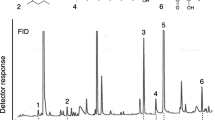Summary
Trail pheromone production and trail following behaviour of workers ofMyrmica rubra of different age groups, categorized by their cuticular pigmentation, were analysed.
The dimensions of the poison gland reservoir increase as workers grow older. No trail pheromone could be detected in callows. Its activity, as measured by the reactions of ants to it, appears and increases as ants grow older, the workers responding to their trail pheromone throughout adult life, although their response becomes increasingly obvious as the ants become older. The oldest ants, the foragers, are thus able to emit the largest amount of trail pheromone and follow more readily their own and congeners' trails. These capabilities help the colony when recruitment to repel an enemy or to exploit a source of food occurs in its foraging area.
Résumé
Les ouvrières d'une société deMyrmica rubra sont réparties en catégories d'âge sur la base de leur pigmentation cuticulaire (Cammaerts-Tricot, 1974c, fig. 1). Le présent travail analyse la production de phéromone de piste par des fourmis de teintes différentes ainsi que leur tendance à y répondre.
Les dimensions du réservoir de la glande à poison augmentent avec l'âge des fourmis. L'activité des extraits de ces glandes croit quand les ouvrières vieillissent. Chez les plus jeunes individus, nous ne détectons guère de phéromone de piste.
Les fourmis peuvent répondre à leur phéromone de piste dès après leur mue imaginale. Cette réaction est d'autant plus nette que lesM. rubra sont plus âgées.
Les plus vieilles ouvrières, c'est-à-dire les fourrageuses, peuvent donc émettre de grandes quantités de phéromone de piste et suivre aisément les traces de leurs congénères. Ces deux aptitudes sont certes avantageuses quand un recrutement d'ouvrières vers une proie ou un ennemi survient sur l'aire de récolte d'une société.
Similar content being viewed by others
References
Blum (M. S.) andRoss (G. N.), 1965.—Chemical releaser of social behaviour. V Source, specificity and properties of the odour trail pheromone ofTetramorium guineense.J. Insect Physiol., 11, 857–868.
Cammaerts-Tricot (M.-C.), 1974a.—Recrutement d'ouvrières, chezMyrmica rubra, par les phéromones de l'appareil à venin.Behaviour, 50, 111–112.—Cammaerts-Tricot (M.-C.), 1974b. Piste et phéromone attractive chez la fourmiMyrmica rubra. J. of Comp. Physiol., 88, 373–382.—Cammaerts-Tricot (M.-C.) 1974c. Production and perception of attractive pheromones by different aged workers ofMyrmica rubra (Hymenoptera, Formicidae).Ins. Soc. (à paraître).
Moser (J. C.) andBlum (M. S.), 1963.—Trail marking substance of the texas leaf-cutting ant. Source and potency.Science, 140 (14), 1228.
Topoff (H.), Boshes (M.) andTrakimas (W.), 1972.—A comparison of trail following between callow and adult workers of the army ant (Neivamyrmex nigrescens) (Formicidae: Dorylinae).Animal Behaviour, 20, 361–366.
Pasteels (J.-M.) andVerhaeghe (J.-C.), 1974.—Dosage biologique de la phéromone de piste chez les fourrageuses et les reines deMyrmica rubra. Ins. Soc. (à paraître).
Weir (J. S.), 1958.—Polyethism in workers of the antMyrmica, Pt. II.Ins. Soc., 5 (3), 315–399.
Author information
Authors and Affiliations
Rights and permissions
About this article
Cite this article
Cammaerts-Tricot, M.C., Verhaeghe, J.C. Ontogenesis of trail pheromone production and trail following behaviour in the workers ofMyrmica rubra L. (Formicidae). Ins. Soc 21, 275–282 (1974). https://doi.org/10.1007/BF02226918
Received:
Accepted:
Issue Date:
DOI: https://doi.org/10.1007/BF02226918




